PARVOVIRIDAE
Naked, ssDNA
General Properties
Small and simple virus particles (Latin parvo = small).
These are the smallest of the DNA viruses.
Parvoviruses are significant pathogens in the veterinary sciences.
The only family of DNA viruses that infect humans that is single stranded.
Unlike the papovaviruses, cannot induce DNA synthesis in host cells and require cell division for their replication.
Heat-resistant (56°C for 60 min) than most other viruses.
Can also withstand various treatments with proteases, nucleases, detergents, lipid solvents, and weak acids (pH3.0).
For these reasons, they may persist for long periods of time (months) in the environment and be capable of infectionof new susceptible hosts.
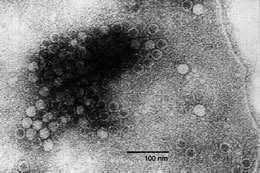
Electron micrographs of Parvovirus
Images from the ICTV website
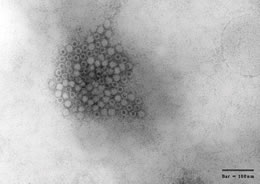
Electron micrographs of Parvovirus
Images from the ICTV website
Taxonomy
Family: Parvoviridae
Subfamily: Chordoparvovirinae (in vertebrates)
Parvovirus (mammals & birds)
Erythrovirus (human B19-like virus)
Dependovirus (adeno-associated viruses- AAVs) in mammals
Subfamily: Entomaparvovirinae (in invertebrates)
Densovirus (insect parvovirus group A)
Iteravirus (insect parvovirus group B)
Contravirus (insect parvovirus group C)
Members of each species are probably antigenically distinct, and natural infection is confined to a single host species.
Structure
Icosahedral and isometric capsids measuring 18-26 nm in diameter.
Coat composed of 60 molecules of capsid protein (VP2) made of three to four comparatively large (60-80 kDa) proteins.
The VP2 protein makes up the majority of the capsid, with a small portion of VP1 extending out from the capsid as a receptor for host-cell binding
Other two large proteins (VP1 and VP3) are found in smaller amounts in all parvoviruses.
Non-enveloped viruses with T=1 symmetry.
The surface projections are small, the surface appears rough and there are distinct spikes.
The virion contains no viral or cellular enzymes.
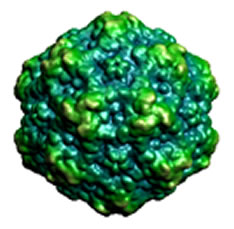
Computer models of the capsid structure of Parvovirus
Source: ICTV
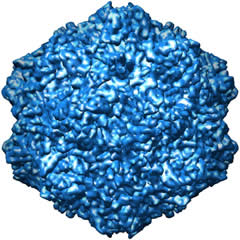
Computer models of the capsid structure of Parvovirus
Source: ICTV
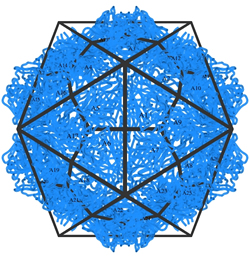
T=1 icosahedron
Genome
Autonomous Viruses
The genome is not segmented and contains a single molecule of linear, ss-DNA in most mature virions.
The linear genome is around 5.6 kb in length, and contains 5 genes, two non-structural (NS1 and 2) and either two (HPV B-19) or three (AAV) structural (VP1, 2, and 3) proteins, depending on the virus.
DNA molecule is 1.5 million Daltons.
Genome sequence has terminal repeated sequences; repeated at one end, or repeated at both ends.
The genome is self-priming because the ends are self-complementary, forming hairpin turns at both termini.
The 3'-terminus has conserved nucleotide sequences of 115-116 nucleotides in length.
3'-terminal sequence has palindromic arrangement (interrupted by two smaller internal palindromic sequences), or palindromic repeats folding into a T- or Y-shaped structure.
The DNA of the autonomous parvoviruses has not been found to be infectious.
Dependoviruses
Adeno-Associated Viruses (AAV) establish a latent infection in which its DNA integrates into the host chromosome 19.
Latent infection in humans appears to be common.
Dependoviruses require a helper virus for replication.
They can only replicate in cells that are infected by an Adenovirus, a Herpesvirus, or a Papillomavirus.
Dependent on Adenovirus or Herpesvirus superinfection for the provision of further helper functions essential for their replication.
The Adenovirus genes require as helpers are the early, transcriptional regulatory genes rather than the late structural genes.
The help appears to be for the modification of the cellular environment (probably affecting transcription of the defective Parvovirus genome) rather than for a specific virus protein.
With the dependoviruses, both termini contain the same inverted repeats.
They are never produced in great amounts in culture and often cause no detectable cytopathology.
Only the Adeno-associated virus (AAV) dsDNA form has been found to be infectious when a helper virus is present.
More than 90% of human adults have antibodies to AAV, which shows that the virus is widely distributed and common.
Replication
The receptor needed for attachment of a parvo-virus to the cell has not yet been determined.
Virus penetrates into the host cell.
Uncoating and release of the viral genomic ssDNA into the nucleus.
Virus depends on host for replication enzymes.
Since the parvoviral genome is single-stranded DNA, it does not need any special polymerases for replication.
Replication seems to proceed without circularization and without the need for RNA primers.
Replication occurs through rolling-hairpin mechanism, whith NS1 nickase binding covalently to the 5’ genomic end.
Involves double-stranded intermediates and the formation of concatamers (multiple genomes strung together) which are then cleaved for packaging.
Individual ssDNA genomes are excised from replication concatemers by a process called junction resolution.
The mechanism, however, for this site-specific cleavage is unknown.
The ssDNA is converted into dsDNA by cellular proteins.
These newly synthesized ssDNA can either
a) Be converted to dsDNA and serve as a template for transcription/replication b) Be encapsidated to form new virions that can budd out of the host cell.
Viral mRNAs are transcribed when host cell enters S phase and translated to produce viral proteins.
Final Steps of Replication
During assembly the basic structure of the virus particle is formed in the nucleus.
Synthesis of the coat proteins occurs after the synthesis of the non-structural proteins.
Progeny virus is observed after 24 hours.
Virus replication leads to death of the cells.
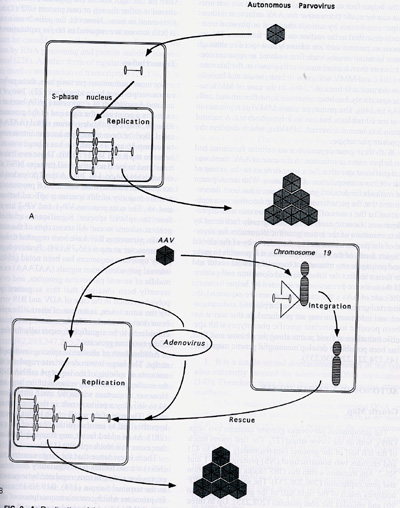
Replication of parvoviruses.
Source: Fields et
al., 1995. Lippincott Williams & Wilkins.
Human Pathogens
Genus Parvovirus
RA-1 virus has been associated with rheumatoid arthritis.
Genus Erythrovirus
Human Parvovirus B-19.
The cause of aplastic crisis in hemolytic anemias and sickle-cell disease, erythrema infectiosum or fifth disease, and spontaneous abortion, fetal death, and hydrops fetalis.
Genus Bocavirus (tentative)
A recent virus isolated from human respiratory tract samples.
The virus has been detected in 17 humans particularly children with lower respiratory tract infections.
This may be a newer virus that causes disease in humans.
Animal Diseases
Genus
Parvovirus:
Feline panleukopenia virus
Canine parvovirus
Minute virus of canines
Mink enteritis virus
Aleutian mink disease virus
Bovine parvovirus
Porcine parvovirus
Goose parvovirus
Minute virus of mice
Murine parvoviruses (HB, H-1, Kilham rat virus)
Notes on Canine Parvovirus
Generally not pathogenic in adults hosts but in younger hosts parvoviruses take a large toll.
Pure breeds are more susceptible.
The spread of parvoviruses may be by feces, urine, saliva, nasal secretion, genital fluids.
The virus hemagglutinates erythrocytes of certain animal species and can be quantified by this process.
Houses and grounds previously inhabited by a parvo-infected dog need to be decontaminated before introducing a new dog into the area.